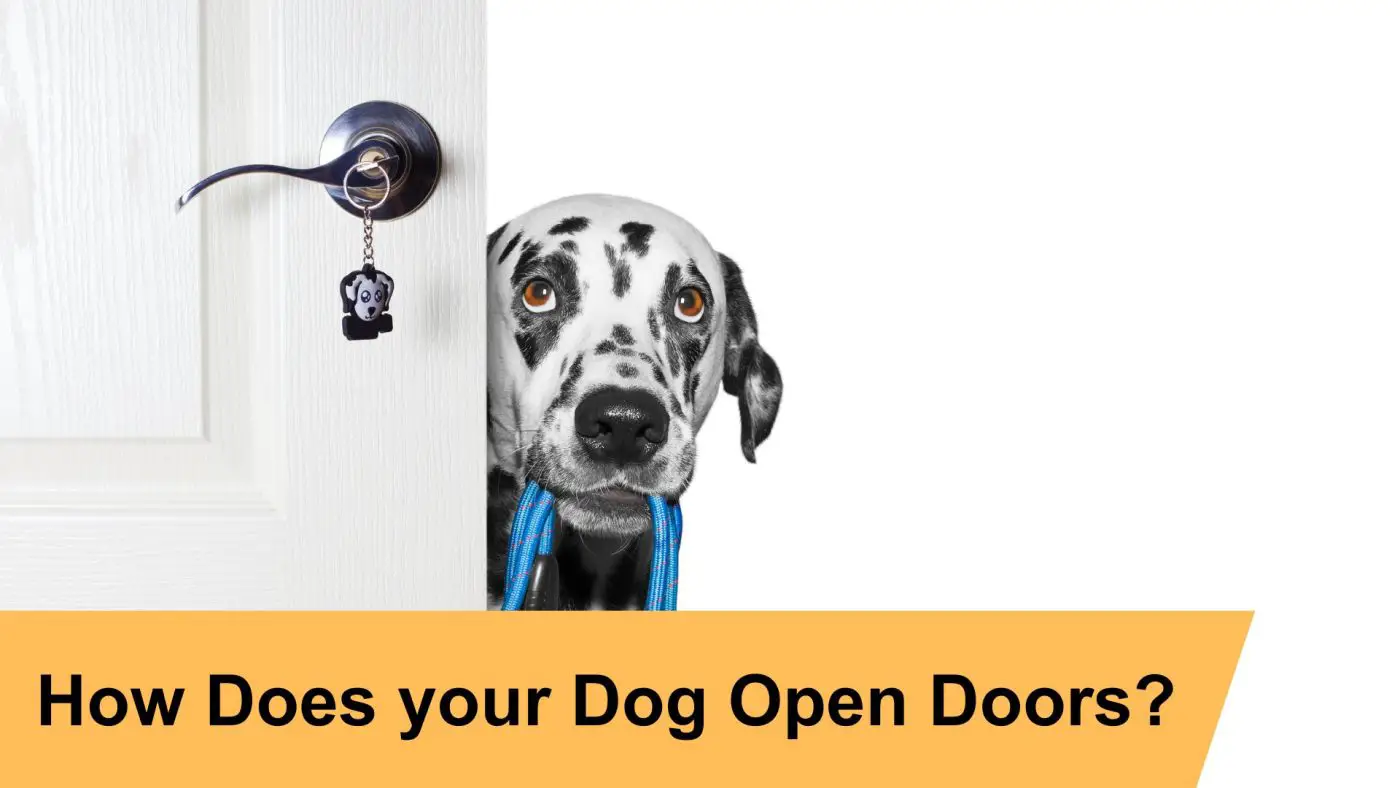Is your dog exhibiting an impressive talent for opening doors and cabinets, resulting in unrestricted access throughout your home? Have they mastered nudging open sliding glass doors, manipulating French door latches, or scratching their way into cabinets and refrigerators, treating themselves to an impromptu snack?
I can completely relate to your predicament.
When my own Labrador mix, Rocket, first discovered the knack for opening doors, it felt like a scene from a movie! It all started when he jumped at the door in an attempt to enter, accidentally triggering the latch and causing the door to swing open.
From that moment on, Rocket was determined to explore every room in the house. He would paw at doors, leap, and leave scratches on the paint and underlying wood, eagerly striving to uncover what lay beyond!
While I didn’t mind this behavior at times, it soon became a major inconvenience when Rocket started venturing into restricted areas, causing damage or accessing items that posed a risk to his well-being. Realizing the need for a solution, I knew it was time to take action.
Why Do Dogs Want To Open Doors?
Dogs are intelligent creatures. Their natural intelligence is one of the reasons why these furry friends have become such popular pets worldwide. However, sometimes their smartness can lead to destructive behaviors, such as trying to open doors.
Many dogs seem fascinated with doors and will try to do whatever it takes to get to the other side. There could be several reasons why dogs want to open doors.
Perhaps they see it as a challenge or a game they want to win. It’s also possible they are trying to escape or get into a room where their owners are.
And in some cases, service dogs themselves may have been trained by service dog trainers for tasks like opening doors for people with disabilities. Golden Retrievers, for example, is known for being particularly good at door pawing and target training due to their obedience and intelligence levels.
But many other breeds love opening doors, so any dog owner should pay attention. If you’re wondering how to stop your dog from opening doors, you can follow several safety tips, such as using childproof locks or training your dog with a simple command like “leave it.” However, before we get into that, let’s dive into the types of doors most prone to being opened by our furry friends.

How To Fix This Behavior
If you’re tired of your dog constantly opening doors, don’t worry! You can fix this behavior with some patience and training.
Many dogs are naturally intelligent and can learn quickly with the proper techniques. Firstly, make sure to childproof the locking mechanisms on your doors.
If the door is locked, your dog won’t be able to open it, no matter how hard they try. Round doorknobs are also more difficult for a dog to turn than lever-style handles, so consider replacing round door knob with those if possible.
Next, target training can effectively teach your dog not to open doors. Place a small object like a bell or button on the door handle and use a simple command like “leave it” or “no” when your dog tries to touch it.
Eventually, stop using the object and use the command when they approach the door handle. For young dogs or those who are particularly stubborn, a physical barrier like a baby gate or screen door can prevent them from even getting close enough to attempt opening doors.
If all else fails and you need to allow your dog access through particular doors, consider installing a specialized dog door or teaching them how to use a master door opener. This can give them their own designated entrance while keeping other areas off-limits.
Remember that any training takes time and consistency. With patience and perseverance, you can teach your furry friend how to open doors and behave appropriately around them!
Types of Doors That Are Most Prone To Being Open

Dogs are intelligent animals, and some breeds, like German Shepherds, are known for their ability to learn complex tasks. One of these dog learned tasks is learning how to open doors.
But not all doors are created equal when it comes to dog-proofing. Sliding glass doors are a popular entry point for dogs who want to escape or explore the backyard.
They’re easy to slide open with a paw or nose, and the handle is within reach for most dogs. Childproof locking mechanisms can help prevent this problem.
Lever-style handles are another common type that dogs can easily manipulate with their paws. This door type is more challenging to childproof than round knobs, but it’s still possible with a lock designed explicitly for lever-style handles.
Round knobs are virtually impossible for dogs to turn with paws or noses. However, some breeds have been taught how to use their mouths and jaws to hang them.
Even so, round knobs are still less prone than other types of doors. French doors can be challenging because they often have a master door opener in the middle, making it easier for the dog to push one side of door open while using their paws on the other.
When it comes down to it, any door can be opened by a determined dog trained well enough (or has enough natural aptitude) to open them. Therefore, safety tips include always keeping your pup properly trained and supervised!
How To Fix Dogs Opening French Doors
French doors can be a little tricky when it comes to dogs. They often have round knobs, which are easier for paws to grasp and turn than a lever or handle-style doorknobs.
If your dog is opening French doors, the first step is to ensure they are adequately secured with a lock or latch that your dog cannot manipulate. A screen protector can also be added for extra protection.
If your dog has already learned how to open the French door, there are a few things you can do. One option is to teach them a specific command that indicates they should not open the door without permission.
A professional dog trainer can help you with your dog taught using this technique. Another method is to create a barrier between your dog and the door using furniture or obstacles that keep them from where they can reach the door knob or handle.
If all else fails, you may need to consider replacing the French doors with another type of door that your dog cannot open. Remember, this behavior can be frustrating, but it’s important to keep our dogs safe and secure so they can enjoy their life indoors without risking themselves or others around them.
What To Do About A Dog Opening Sliding Doors
Sliding glass doors can be particularly problematic if your dog has learned to open them. These doors are smooth and easy to slide open, and the handle is often reachable even for smaller dogs. If your dog learns it can push the gate with its front paws, it can easily open the door with its hind legs.
One solution is to install childproof locking mechanisms on the sliding glass doors. This child proof locks will make it virtually impossible for your dog to open the door.
Another option is to teach your dog to wait before opening the door or only open it when given a simple command. To prepare your dog not to open sliding doors, teach basic obedience commands like “sit” and “stay.” Then, teach your dog to push things with its nose or paw.
You can use this skill to teach them a pushing action that will help them learn how to close or open a sliding glass door themselves. If all else fails, you may need to physically block access or keep an eye on your dog whenever they are near the sliding glass doors.
It’s important not to leave anything in front of the door that your furry friend could use as a step stool. Most dogs are intelligent and curious animals who love exploring their surroundings.
However, this curiosity may sometimes lead them into trouble if left unchecked. With patience and consistency, you can teach your furry friend not to open inappropriate doors without putting too much stress on their attitude.
How To Stop Your Dog Opening Cabinet and Refrigerator Doors

Many dogs love to explore and find new things. However, curiosity can lead them to open cabinets and refrigerators for tasty treats.
Suppose your dog has a habit of opening doors that they shouldn’t; don’t worry! There are several ways you can stop this bad behavior.
Firstly, you can install childproof locks on your cabinets and refrigerator doors. These locks are virtually impossible for dogs to figure out how do dogs know how to open doors.
They require a specific motion to open the door that most dogs cannot replicate. Another option is to use round knobs instead of handles.
Dogs with paws tend to have more trouble opening round knobs than those with traditional handles. If your dog has already learned how to open cabinet or refrigerator doors, put a sticky note on the outside as a reminder for you to check before leaving the room.
Eventually, this will become second nature, and you won’t have to double-check every time you leave. Training your dog is another effective method.
Teach them that opening the door is not allowed by using positive reinforcement when they do not try to access the door opens forbidden areas. This will help them understand what is expected of them.
If all else fails, consider creating a designated” dog roo” where your furry friend can go without having access to anything they shouldn’t have. This way, you won’t have to worry about them getting into trouble while away from home.
Remember that dogs are descendants of wolves and have an inherent instinct for exploring their surroundings in search of food and safety. With patience and training, however, it is possible to stop your dog from opening cabinets or refrigerators inappropriately so both they and your kitchen remain safe from harm!
Dog Proof Door Latch
If you have a furry friend who is a master door opener, investing in a dog-proof door latch may be your solution. These latches are designed to prevent your dog from opening doors, regardless of whether it’s a round knob, knobs or lever-style handles.
Many dogs love exploring and opening doors to see what’s on the other side. Some dogs even attempt to open slightly ajar doors with paws or hind legs!
However, this behavior can quickly become frustrating if it puts your dog in danger or allows them access to harmful items in the house, such as cleaning supplies or human food. Installing childproof locks on cabinets and refrigerator doors that contain yummy stuff is helpful, but it’s not always possible for doors leading outside.
This is where a dog-proof door latch comes in handy. Target training can also be combined with these latches to reinforce good behavior.
Consistently reinforcing positive behaviors can help make your life easier and keep your pup safe. So stick a sticky note reminder somewhere visible and start training today!
Dog Training

Now that you understand why your dog might be opening doors let’s talk about why dogs open doors and how you can train them to stop. First and foremost, it’s important to remember that dogs thrive on positive reinforcement.
Punishing them for opening doors will only confuse them and worsen their behavior. Instead, try redirecting their attention with a toy or treat when they are interested in a door opener.
For young dogs or golden retrievers who are still learning the ropes, installing childproof locks or other childproof locking mechanisms on doors your dog has been known to open may be helpful. This will prevent accidental escapes and give you peace of mind knowing they won’t get into trouble while you’re away.
If your dog has already learned how to open doors, you can take a few different approaches depending on the door type. Installing a stronger latch or door opener may be necessary for screen protectors or other less sturdy barriers.
When working with sliding glass doors or French doors, please keep your dog on the other side of the room while entering and exiting so they don’t learn how to open the door from watching you do it repeatedly. If all else fails, consider enrolling in basic obedience classes where you can work with professionals who will teach your dog how to open a door and other essential behaviors like sit-stay and recall.
Your dog can learn that opening doors is unacceptable with consistent training and patience. Remember, though, that this takes time, so don’t expect instant results!
Use positive reinforcement such as verbal praise and treats when they follow through with desired behaviors like leaving doors alone. And as always, if training is taking longer than expected, contact a professional trainer for help!
Conclusion
Dogs have a natural intelligence that allows them to figure out how to open doors. This behavior can be cute or frustrating, depending on the dog’s attitude and situation. However, with proper training and consistency, door pawing can eventually stop.
For older or smaller dogs that may struggle with opening doors, owners can install a dog-proof door latch or use a sticky note to remind themselves to close the door securely. It’s important to usually a sticky note because that some types of doors, like French and sliding doors, are more prone to being open than others.
Dog trainers can help teach furry friends how to open a door on command properly. It’s also worth noting that certain breeds older dogs, like Golden Retrievers and German Shepherds, may be more prone to opening doors due to their natural intelligence and problem-solving skills.
Overall, while it may seem virtually impossible for dogs to open a door, owners must remain vigilant about keeping their homes secure for both their pet’s safety and the safety of others; with patience and consistency, one day, your furry friend may even learn to open the front door like a pro!
Frequently Asked Questions
Why does my dog know how you open doors?
Dogs can learn how to open doors through observation, trial and error, or unintentional reinforcement. They may observe humans opening doors and attempt to mimic the behavior, or they may accidentally discover how to open doors through pawing or nudging.
How do dogs know who is at the door?
Dogs can use their acute senses, including hearing and smell, to recognize familiar sounds or scents associated with specific individuals approaching the door. They may also pick up on cues from the behavior or reactions of people in the household.
How do dogs know what room you are in?
Dogs can have a strong sense of hearing and smell, allowing them to detect sounds and scents associated with specific rooms or areas of the house. They may also observe human movements or routines to determine where people are located.
Can a dog open a locked door?
While some dogs may have the ability to open unlocked or partially closed doors with their paws, nose, or by jumping on handles, most dogs cannot open locked doors without specific training or physical capabilities. However, it is essential to ensure that doors are securely closed and inaccessible to prevent any safety concerns.





